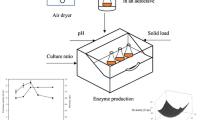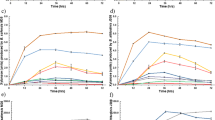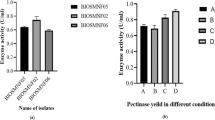Abstract
In this research, the production of exo-pectinase by Bacillus pumilus using different agricultural wastes was studied. Agricultural wastes containing pectin such as wheat bran, sugar beet pulp, sunflower plate, orange peel, banana peel, apple pomace and grape pomace were tested as substrates, and activity of exo-pectinase was determined only in the mediums containing sugar beet pulp and wheat bran. Then, effects of parameters such as concentrations of solid substrate (wheat bran and sugar beet pulp) (A), ammonium sulphate (B) and yeast extract (C) on the production of exo-pectinase were investigated by response surface methodology. First, wheat bran was used as solid substrate, and it was determined that exo-pectinase activity increased when relatively low concentrations of ammonium sulphate (0.12–0.21 % w/v) and yeast extract (0.12–0.3 % w/v) and relatively high wheat bran (~5–6 % w/v) were used. Then, exo-pectinase production was optimized by response surface methodology using sugar beet pulp as a solid substrate. In comparison to P values of the coefficients, values of not greater than 0.05 of A and B 2 showed that the effect of these process variables in exo-pectinase production was important and that changes done in these variables will alter the enzyme activity.









Similar content being viewed by others
References
Amin F, Bhatti HN, Bhatti IA, Asgher M (2013) Utilization of wheat bran for enhanced production of exo-polygalacturonase by Penicillium notatum using response surface methodology. Pak JAgri Sci 50(3):469–477
Bhanu Prakash GVS, Padmaja V, Siva Kiran RR (2008) Statistical optimization of process variables for the large-scale production of Metarhizium anisopliae conidiospores in solid-state fermentation. Bioresour Technol 99:1530–1537
Blandino A, Iqbalsyah T, Pandiella SS, Cantero D, Webb C (2002) Polygalacturonase production by Aspergillus awamori on wheat in solid-state fermentation. Appl Microbiol Biotechnol 58:164–169
Chandra R, Takeuchi H, Hasegawa T (2012) Methane production from lignocellulosic agricultural crop wastes: a review in context to second generation of biofuel production. Renew and Sustain Energy Rev 16:1462–1476
Claudete Fontana R, Moura da Silveira M (2012) Production of polygalacturonases by Aspergillus oryzae in stirred tank and internal- and external-loop airlift reactors. Bioresour Technol 123:157–163
Elibol M, Ozer D (2002) Response surface analysis of lipase production by freely suspended Rhizopus arrhizus. Process Biochem 38:367–372
Fang TJ, Liao BC, Lee SC (2010) Enhanced production of xylanase by Aspergillus carneus M34 in solid-state fermentation with agricultural waste using statistical approach. N Biotechnol 27(1):25–32
Favela Torres E, Volke Sepulveda T, Viniegra Gonzales G (2006) Production of hydrolytic depolymerising pectinases. Food Technol Biotechnol 44(2):221–227
İleri Teknoloji Projeleri (İTEP) Destekleme Programı Raporu (2010) Türkiye Teknoloji Geliştirme Vakfı, Turkey
Jayani RS, Saxena S, Gupta R (2005) Microbial pectinolytic enzymes: a review. Process Biochem 40:2931–2944
Kashyap DR, Kumar Soni S, Tewari R (2003) Enhanced production of pectinase by Bacillus sp. DT7 using solid state fermentation. Bioresour Technol 88:251–254
Kaushik R, Saran S, Isar J, Saxena RK (2006) Statistical optimization of medium components and growth conditions by response surface methodology to enhance lipase production by Aspergillus carneus. J Mol Catal B Enzym 40:121–126
Klug Santner BG, Schnitzhofer W, Vrsanska M, Weber J, Agrawal PB, Nierstrasz VA, Guebitz GM (2006) Purification and characterization of a new bioscouring pectate lyase from Bacillus pumilus BK2. J Biotechnol 121:390–401
Li Y, Liu Z, Zhao H, Xu Y, Cui F (2007) Statistical optimization of xylanase production from new isolated Penicillium oxalicum ZH-30 in submerged fermentation. Biochem Eng J 34:82–86
Maisuria VB, Nerurkar AS (2012) Biochemical properties and thermal behaviour of pectate lyase produced by Pectobacterium carotovorum subsp. carotovorum BR1 with industrial potentials. Biochem Eng J 63:22–30
Martin N, Regina de Souza S, Silva R, Gomes E (2004) Pectinase production by fungal strains in solid-state fermentation using agro-industrial bio product. Braz Arch Biol Technol 47(5):813–819
Martins ES, Silva D, Da Silva R, Gomes E (2002) Solid state production of thermostable pectinases from thermophilic Thermoascus aurantiacus. Process Biochem 37:949–954
Miller GL (1959) Use of dinitrosalicylic acid reagent for determination of reducing sugars. Anal Chem 31:426–428
Montgomery DC (2009) Response surface methods and designs chapter 11, design and analysis of experiments, Arizona State University, 7th edn, John Wiley & Sons, Inc. pp 417-440
Panesar PS, Chavan Y, Chopra HK, Kennedy JF (2012) Production of microbial cellulose: response surface methodology approach. Carbohyd Polym 87:930–934
Patil SR, Dayanand A (2006) Exploration of regional agrowastes for the production of pectinase by Aspergillus niger. Food Technol Biotechnol 44(2):289–292
Prakasham RS, Subba Rao C, Sarma PN (2006) Green gram husk-an inexpensive substrate for alkaline protease production by Bacillus sp. in solid-state fermentation. Bioresour Technol 97:1449–1454
Puri S, Beg QK, Gupta R (2002) Optimization of alkaline protease production from Bacillus sp. by response surface methodology. Curr Microbiol 44:286–290
Rastogi NK, Rashmi KR (1999) Optimisation of enzymatic liquefaction of mango pulp by response surface methodology. Eur Food Res Technol 209:57–62
Rehman HU, Qader SAU, Aman A (2012) Polygalacturonase: production of pectin depolymerising enzyme from Bacillus licheniformis KIBGE IB-21. Carbohyd Polym 90:387–391
Rezazadeh Bari M, Alizadeh M, Farbeh F (2010) Optimizing endopectinase production from date pomace by Aspergillus niger PC5 using response surface methodology. Food Bioprod Proc 88:67–72
Sarmah AK (2009) In: Ashworth GS, Azevedo P (eds) Potential risk and environmental benefits of waste derived from animal agriculture chapter 1, agricultural wastes agriculture issues and policies series. Nova Science Publishers Inc, New York
Sharma DC, Satyanarayana TA (2006) A marked enhancement in the production of a highly alkaline and thermostable pectinase by Bacillus pumilus dcsr1 in submerged fermentation by using statistical methods. Bioresour Technol 97:727–733
Singh nee’ Nigam P, Pandey A (2009) Biotechnology for agro-industrial residues. Springer, Poonam Singh nee’ Nigam and Ashok Pandey Editors
Singh nee’ Nigam P, Gupta N, Anthwal A (2009) Utilisation pre-treatment of agro-industrial residues, chapter 2, biotechnology for agro-industrial residues. Springer, Poonam Singh nee’ Nigam and Ashok Pandey Editors
Swain MR, Kar S, Ray RC (2009) Exo-polygalacturonase production by Bacillus subtilis CM5 in solid state fermentation using cassava bagasse. Braz J Microbiol 40:636–648
Ustok FI, Tari C, Gogus N (2007) Solid-state production of polygalacturonase by Aspergillus sojae ATCC 20235. J Biotechnol 127:322–334
Acknowledgments
The authors wish to thank FÜBAP (The Research Foundation of Firat University) for the financial support of this study (Project no. FÜBAP 1674). The authors want to express their thanks to Prof. Dr. Murat Elibol, Department of Bioengineering, Ege University, Izmir, Turkey, for supporting on optimization.
Author information
Authors and Affiliations
Corresponding author
Additional information
Responsible editor: Philippe Garrigues
Rights and permissions
About this article
Cite this article
Tepe, O., Dursun, A.Y. Exo-pectinase production by Bacillus pumilus using different agricultural wastes and optimizing of medium components using response surface methodology. Environ Sci Pollut Res 21, 9911–9920 (2014). https://doi.org/10.1007/s11356-014-2833-8
Received:
Accepted:
Published:
Issue Date:
DOI: https://doi.org/10.1007/s11356-014-2833-8




